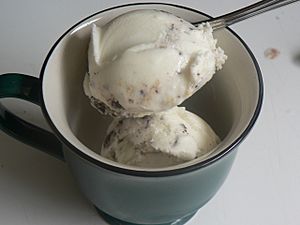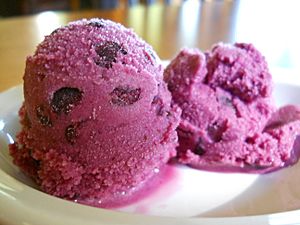Frozen yogurt facts for kids

Tart flavored frozen yogurt
|
|
| Place of origin | United States |
|---|---|
| Serving temperature | Frozen |
| Main ingredients | Milk solids, sweetener, yogurt culture |
Frozen yogurt is a yummy frozen treat. People also call it frogurt or Froyo. It is made with yogurt and sometimes other dairy or non-dairy ingredients. Think of it like ice cream, but it has special live bacterial cultures in it.
Frozen yogurt often tastes a bit more tangy than regular ice cream. This tanginess comes from the lactic acid in the yogurt. It also usually has less fat because it uses milk instead of cream. Frozen yogurt is different from ice milk or regular soft serve. In the U.S., the Food and Drug Administration (FDA) does not regulate frozen yogurt. However, some U.S. states, like California, do have rules for it.
Contents
How Is Frozen Yogurt Made?
Frozen yogurt is made from a few main things. These include milk solids, a type of sweetener, milk fat, and special yogurt cultures. The most common cultures are Lactobacillus bulgaricus and Streptococcus thermophilus. Sometimes, flavorings and colors are added too.
The milk fat in frozen yogurt is usually between 0.55% and 6%. It helps make the yogurt taste rich. Milk solids make up 8% to 14% of the yogurt. They add lactose for sweetness and proteins for a smooth texture. These proteins also help the yogurt melt slower. Sugar, either from beets or cane, makes up 15% to 17% of the ingredients. Besides making it sweet, sugar adds to the solid ingredients. This improves the yogurt's body and texture.
To keep the yogurt smooth and stop ice crystals from forming, Gelatin or plant-based additives are used. These include guar gum and carrageenan. These stabilizers also help the yogurt stay firm even if the temperature changes a bit.
The Production Process
Big companies often have special factories just for making frozen yogurt. First, they mix the milk products and stabilizers together. This mixture is then homogenized, which means it is blended very smoothly. At 32°C, the yogurt cultures are added. The mix stays at this temperature until it becomes thick.
Next, the mixture is cooled down to between 0°C and 4°C. Once it reaches the right temperature and thickness, it sits in special tanks for up to four hours. After this, sweeteners, flavors, and colors are mixed in. The yogurt mixture is then cooled even more, to between -6°C and -2°C.
To make the yogurt creamy and increase its volume, air is mixed into it. This happens while the mixture is stirred. With enough air, the yogurt is quickly frozen. This fast freezing stops large ice crystals from forming. Finally, the frozen yogurt is stored in a cold place until it is ready to be shipped out.
Making Soft-Serve Frozen Yogurt
Frozen yogurt can also be made in a soft serve machine. This is similar to how soft ice cream is made. You can buy frozen yogurt mix as a powder that you mix with water. Or, you can get it as a liquid that is ready to pour into the machine.
You can choose a mix with high or low-fat content. The amount of air added to the soft-serve frozen yogurt can also be changed. If the mix has more fat, it can hold more air. The more air that goes into the mix as it freezes, the creamier the final product will taste.
How Is Frozen Yogurt Used?
Frozen yogurt comes in many different flavors and styles. You can also find sugar-free and fat-free options. Frozen yogurt shops usually offer lots of toppings. These can be anything from fresh fruit and nuts to popular cookie brands and candies.
Some companies make a more tart version of frozen yogurt. This is closer to the original recipe. Other companies try to make their frozen yogurt taste more like ice cream.
See also
 In Spanish: Yogur helado para niños
In Spanish: Yogur helado para niños



